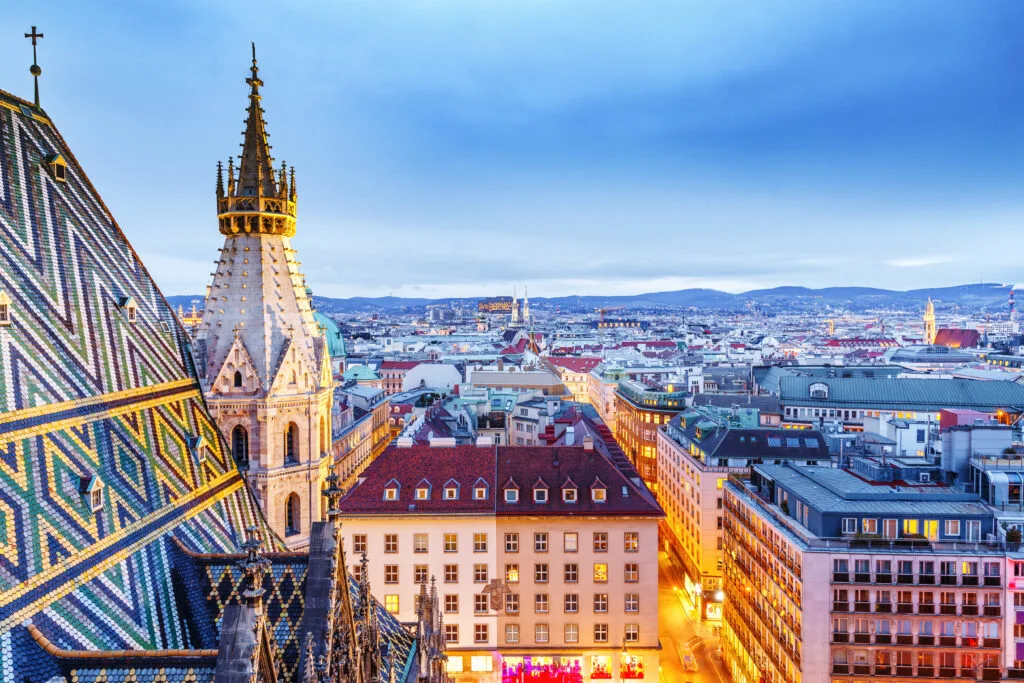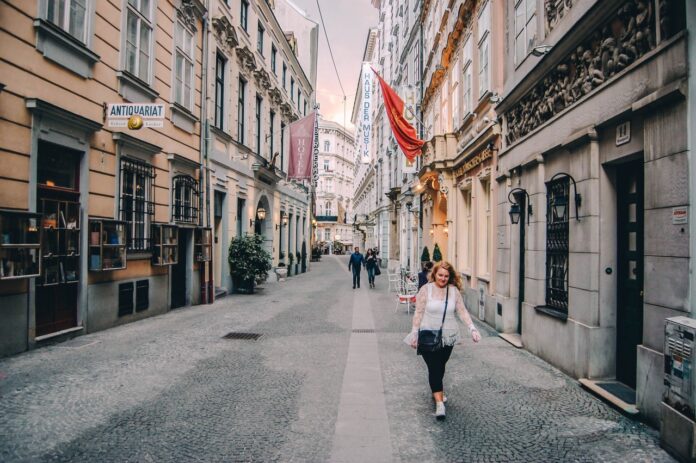As the capital of Austria, it’s clear that there’s no shortage of delightful, whimsical, and downright fun things to do when it comes to Vienna. Even if you’re only in the city for a short period of time, you can certainly pack in activities, particularly thanks to the fact that the main attractions of Vienna are condensed into a fairly small area. Here’s how to spend the perfect one day in Vienna itinerary.
Please note that Vienna is known locally as Wien.

What is Vienna known for?
Located alongside the banks of the Danube River, Vienna is known as the city of Music thanks to its association with a number of famous composers, including Mozart and Bach. The local language is Viennese German and some of the most famous attractions in the city today are grand cafés, illustrious palaces, and the opera.
The city is also home to one of the best Christmas Markets in Europe, with crowds flocking to the Austrian capital from all over the world come the colder months of the year. For more information, be sure to check out our complete Vienna Christmas Market guide.

Get updates on the latest posts and more from solosophie straight to your inbox.

Is one day enough time in Vienna?
As a major European capital with no fewer than 100 museums and other incredible attractions, you would ideally want to spend at least three days in the city. Of course, travel schedules don’t always permit the luxury of a longer break in the city and so one day in Vienna is sufficient if you simply want to get a feel for the city and see a few of its main attractions.
This includes visiting a couple of museums, sampling some restaurants, and enjoying some of the most picturesque spots in the city. If you wish to see even more of Austria and even take some day trips from Vienna, then you’ll want to stay at least four or five days.

Suggested one day in Vienna itinerary
Head for breakfast at a café
Vienna is famed for its illustrious cafés and so it only makes sense to begin your time in the city by checking out one of these institutions for yourself. Some of the best spots to head to for breakfast include Demel, Cafe Central, and Aida.
Whichever spot you choose to head to for your first meal of the day, be prepared to wait up to half an hour to be seated as these spots are incredibly popular (especially during high season, i.e. summer). Be sure to try a traditional Viennese breakfast which features coffee and pastries.

Mozart’ Apartment Museum
One of the top attractions that most visitors add to their bucket list in Wien is the Mozart Apartment, which is allegedly where the iconic composer composed more music than anywhere else.
The apartment also happens to be the only home that belonged to Mozart that still exists and is now curated by the Wien museum. Today, the three storey former home includes exhibitions and collections regaling Mozart’s life and works. As of 2023, a full priced adult ticket costs €12.
Vienna Cathedral
St Stephen’s Cathedral is one of Vienna’s greatest monuments and dates all the way back to the first half of the 12th-century, though it wasn’t completed until the latter half of the 16th-century. Entrance into the main building is free and highlights include the 16th-century Late Gothic organ case and 15th-century Wiener-Neustadter Altar.
For a fee, you can climb up to the roof, where you’ll be rewarded with one of the most beautiful viewpoints the city has to offer. Climbing the 343 steps to reach the top of the south tower also offers the chance to get tangibly close to the stunning roof tiles. In total, there are over 230,000 ornately patterned glazed tiles.

St Peter’s Church
Yet another ecclesiastical building which shouldn’t be missed during a trip to Vienna is St Peter’s Church. This impressive building was constructed during the 18th-century and is one of the most beautiful examples of Baroque architecture in the city today.
Entrance to the church is free and highlights include fresco painted ceilings and ornate carvings at almost every turn. If you truly want to enjoy the church in all of its glory, you might consider booking an evening concert like this one.

Hofburg
Unfortunately, with just 24 hours to explore Vienna, you won’t be able to fully see all of the impressive Palaces that Vienna has to offer. With this being said, you can still admire some of them via their exteriors, including Hofburg, which is only a short walk away from St Peter’s Church.
The Hofburg Palace was built in the 13th-century and was used as the former principal imperial palace of the Hasburg Dynasty. Today, the mammoth building has been transformed into a museum which hosts all sorts of exhibits, including displays on everything from silverware to antiquities.
Sample traditional food for lunch
If you’re a meat eater, then no doubt you’ll have heard of Wiener Schnitzel, which is one of the most traditional dishes of Austria. For those not in the know, this meal typically consists of thinly sliced veal that is dipped in flour, egg and breadcrumbs and then fried.
Schnitzel is usually served with some sort of potato dish and sometimes some salad. as a popular dish, you’ll find that many restaurants across the city serve it. There are even vegan versions available at Velani (Schönbrunner Str. 235, 1120 Wien, Austria) and Landia (Ahornergasse 4, 1070 Wien, Austria).
Museums Quartier
One of the most impressive spots in Vienna is its Museum’s district, which is arguably one of the best areas to enjoy museums in the world. In this area of the Austrian capital, visitors will discover no fewer than 60 cultural institutions.
Unfortunately, if you only have one day in Vienna, there is no way that you can consider visiting more than a handful! Some of the most popular museums in this district include the Belvedere (home to the world’s largest collection of Klimt paintings) and the Museum of Natural History (purchase your museum ticket here in advance).
Vienna State Opera
If you aren’t really a museum person or have other priorities during your time in Vienna, then an alternative option post lunch is to visit the Vienna State Opera. This magical spot is a 1,709-seat Renaissance Revival Opera House and touring the venue is a must for music lovers.
Schönbrunn Palace
After exploring the city centre, head to the regal Schönbrunn Palace, which was once the primary summer residence of the Habsburg rulers. Today, this former royal complex now operates as a museum which will take a couple of hours to fully enjoy.
If you prefer to explore at your own pace, you’ll want to buy a self-guided tour ticket, which will allow you to wander around the 22 Imperial rooms at your own leisure. After touring the interior, you wan stroll around the lavish gardens which include highlights such as a rose garden and impressive water features.
While visiting the Palace, an optional extra is to learn all about the secrets of Apple Strudel making from a chef (and sample some of the pastry for yourself). See full details here. For an even greater look at the history of the palace together with a guide, consider booking this Schönbrunn Palace & Gardens Skip-the-Line Tour.
Attend a classical music concert (with dinner)
End your stay in Vienna the right way by indulging in a favourite Viennese pastime: attending a live music concert. As The City of Music, you can be assured that there’s no shortage of performances to include from. Popular options include attending Vivaldi’s Four Seasons Concert in Karlskirche and enjoying a Classical Concert in St. Anne’s Church.
Those who wish to experience an unforgettable concert might consider booking this Concert in Kursalon with Dinner. Included is a three-course meal while you marvel at opera singers and fascinating ballet soloists. Another dinner option with a view is this evening dinner cruise.
Where to stay in Vienna
Thanks to its status as a major European capital city, there’s no shortage of places to stay in Vienna. Between historic locations which will suit history buffs to budget offerings for those who want to save on accommodation, here are some of the best places to stay in Vienna based on web-reviews and location:
Budget: This no frills hostel offers mixed and single gender dorms in a cosy setting. Private rooms are also available for an extra fee. There’s also Wi-Fi and a bar onsite. Check prices and availability here.
Mid-range: This four-star hotel has a fitness centre and is located just a 2-minute walk from the nearest U-Bahn stop, making it a great base from which to explore the rest of the city. Check prices and availability here.
Luxury: Between the pool, spa, and plush decor of the rooms, you’ll find it hard to pull yourself away from this luxurious hotel to actually go and explore the city. Other amenities include a breakfast buffet and front desk. Check prices and availability here.
What to wear when exploring Europe
In the summer, you can’t go wrong by pairing a cute midi dress with classic white tennis shoes for a laid-back smart casual look that’s just as chic for walking around a city’s cobbled lanes as it is for wandering coastal paths. I love this dress and have it in several colour ways. In terms of tennis shoes, this is my go-to shoe.
When it comes to winter in Europe, most places (with the exception of a few islands) can get pretty cold and so warm layers is a must. I find that cute ankle boots like these ones are the perfect mix of practical meets cute.
Shoulder seasons (spring and summer) in Europe tend to come with a mix of rainy and sunny days and so, again, layers are a must. Trench coats and sneakers are the best uniform to explore the continent in.
Finally, a cross-body bag like these ones is a must. I personally use a crossbody bag by this brand and love its shape, size, and versatility. As well as being convenient and compact, it’s one of the safest ways to transport your valuables, all the while looking chic. I also recommend bringing along a travel adapter like this one so you can charge all of your electronics during your stay!
Source : Solo Shopie

